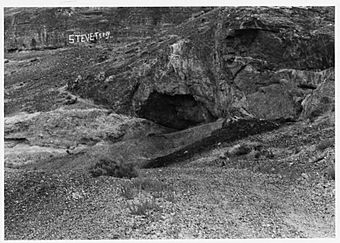Danger Cave facts for kids
|
Danger Cave
|
|
 |
|
| Lua error in Module:Location_map at line 420: attempt to index field 'wikibase' (a nil value). | |
| Location | Tooele County, Utah, United States |
|---|---|
| Nearest city | Wendover, Utah |
| NRHP reference No. | 66000741 |
Quick facts for kids Significant dates |
|
| Added to NRHP | October 15, 1966 |
| Designated NHL | January 20, 1961 |
Danger Cave is a very important archaeological site in western Utah, near the Great Salt Lake. It holds many ancient objects, called artifacts, from a group of people known as the Desert Culture. These artifacts show us what life was like from about 9000 BC to 500 AD.
Scientists used a method called carbon-14 dating to figure out the age of things found in the cave. They found very few signs of people around 11,000 years ago. But by 9,000 years ago, there was much more proof of human life in the Danger Cave area.
Contents
Exploring Danger Cave's Secrets
Danger Cave was first looked at in the 1930s by Elmer Smith. Later, in the 1950s, a professor named Jesse D. Jennings from the University of Utah led a big dig there. Jennings was very careful in how he dug and studied the finds. This made his work special and new for the time.
At first, some people disagreed with Jennings' ideas. But soon, his discoveries became widely accepted. By studying the items from Danger Cave, Jennings helped us understand the ancient Desert Culture. This culture was not well known before his work.
What Made Danger Cave Special?
The cave was very dry, which was perfect for keeping old things safe. This dry air helped preserve many different artifacts. They found tiny beetle wings, pieces of cloth, and even ancient human waste, called paleofeces.
Other amazing finds included:
- Scraps of leather
- Pieces of string and nets made of twine
- Rough fabric
- Parts of baskets
- Tools made from bone and wood, like knives and weapons
- Large grinding stones
In total, scientists found over 2,500 stone tools and more than 1,000 grinding stones. They also found parts of 68 different kinds of plants. These plants still grow near the cave today. Bones from many types of animals were also discovered.
Understanding the Desert Culture
The things found in Danger Cave helped scientists learn about the Desert Culture. These people lived in small groups, probably no more than 25 to 30 people. They moved around a lot and did not build permanent homes.
Their main focus was just surviving. Because of this, they did not create complex traditions or collect many personal belongings. Even with these challenges, the Desert Culture lasted for thousands of years. Their way of life later influenced other early Utah cultures, like the Fremont.
A National Treasure
Because of its importance, Danger Cave was named a National Historic Landmark in 1961. This means it is a place that tells a big part of America's history.

